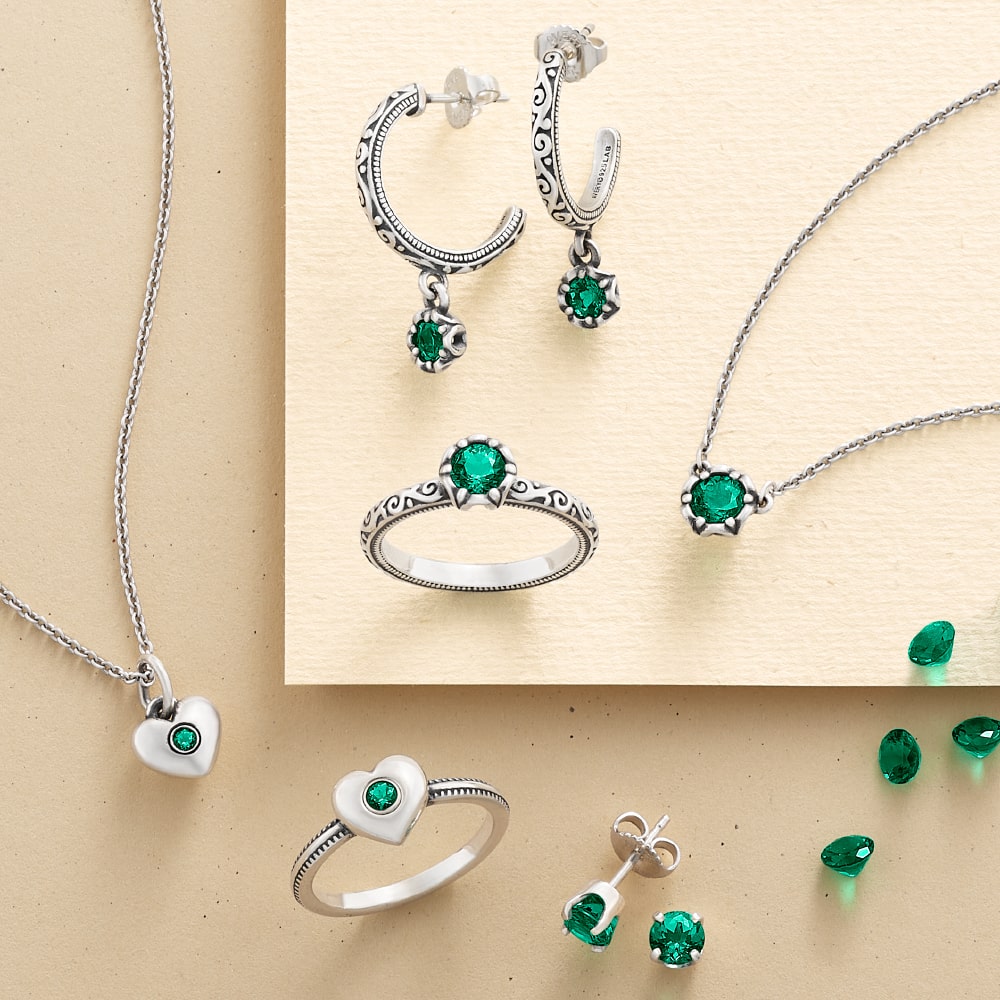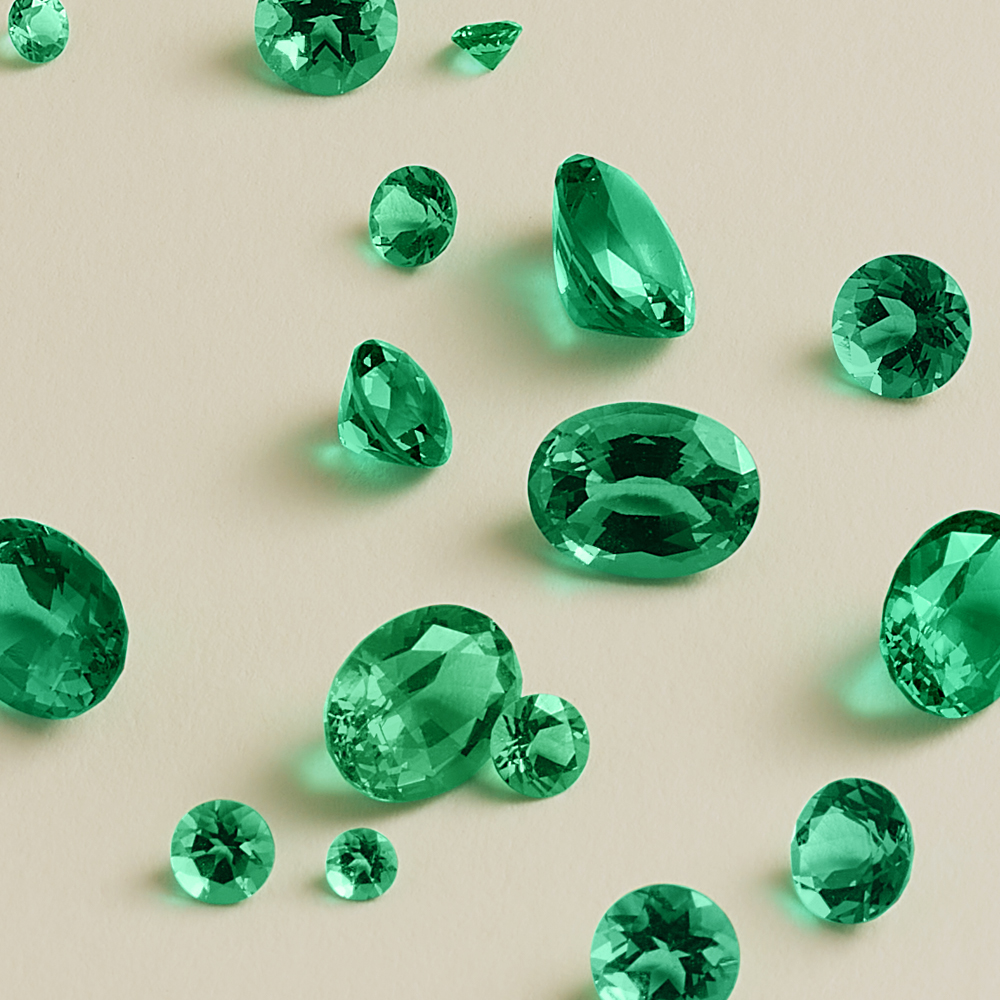May Birthstones

Welcome to the enchanting world of the May birthstone – the emerald. Revered throughout history for its deep green hue, the emerald is often seen as a symbol of renewal, vitality and unending charm. This guide will take you on a journey through emerald's rich history and profound symbolism, as well as the thoughtful care it requires and the myriad ways it can be styled into stunning jewelry designs.
Whether you were born in May yourself or you are simply a gemstone aficionado, you'll enjoy this detailed look into one of nature's most captivating treasures.
What is May’s Birthstone?
May’s birthstone, the emerald, is celebrated for its rich, vibrant green hue, symbolizing renewal and growth. As the birthstone for May, emerald is renowned for its deep color and is often associated with the lush vibrancy of spring. This precious gemstone not only adds a touch of elegance to any jewelry piece but also carries with it a sense of vitality and life, making it a cherished choice for those born in this month.
What Color is the May Birthstone?
Emeralds can come in a wide spectrum of green shades, aside from the famously deep jewel tone of "emerald green." From the palest hints of spring to the deepest forest hues, each shade of emerald tells a unique story of its formation and origin. The variations in color are due to the differing amounts and types of trace elements present during the gemstone's creation.
Emerald Shades and Varieties
Typically, the color of emeralds can be organized into one of a few key categories:
- Light Green Emeralds: These are often found in newer deposits and have a fresh, vibrant appearance. The lighter shades are typically due to lower concentrations of chromium and vanadium.
- Rich, Deep Green: The quintessential emerald shade, this deep, vivid green is highly sought after. High concentrations of chromium and vanadium, often found in Colombian emeralds, contribute to this intense coloring.
- Bluish-Green Emeralds: These unique emeralds have a subtle blue undertone. The presence of both chromium and iron gives them this distinctive hue.
- Yellowish-Green Emeralds: Less common, these emeralds have a warmer tone, resulting from higher concentrations of iron.
Each shade of emerald not only adds to the beauty and uniqueness of the gemstone but also reflects the complex geological processes that formed it.
Emerald Birthstone Meaning and History
 The emerald is a gemstone steeped in history and symbolism and has played a meaningful part in many world cultures over the span of centuries. Even before it was the birthstone for May, it captivated countless people with its beauty and the lore surrounding it.
The emerald is a gemstone steeped in history and symbolism and has played a meaningful part in many world cultures over the span of centuries. Even before it was the birthstone for May, it captivated countless people with its beauty and the lore surrounding it.
The History of Emeralds
Emeralds have been treasured since antiquity, prized for their vibrant green color. The earliest known emerald mines were in Egypt, dating back to at least 330 BC. Cleopatra, the famous Egyptian queen, was known for her passion for emeralds and often used them in her royal wardrobe.
In ancient Rome, emeralds were associated with Venus, the goddess of love and beauty, further solidifying their status as a symbol of allure and allure. The Romans also believed emeralds could improve the wearer’s importance and speak eloquently.
The conquest of South America by the Spanish in the 16th century brought European attention to the emeralds of the New World. The Muzo mines of Colombia, which are still operational today, were discovered and became the most famous source of emeralds globally, known for their unmatched quality and size. In the Mughal Empire, emeralds were highly prized, and the Mughals were known for their intricate carvings on these stones, often with religious text, as the emperors were known for their deep faith and belief in the healing powers of emeralds.
The Renaissance period saw emeralds become a favored gemstone among the nobility, often set in elaborate jewelry pieces and royal insignias, symbolizing status and power. During the Victorian era, Queen Victoria's love for colored gemstones, including emeralds, influenced the jewelry trends of the time. Emeralds were often set in intricate designs combined with other precious stones, reflecting the opulence and romanticism of the era. This period also saw the advent of more innovative cutting techniques, allowing for more sophisticated and diverse emerald jewelry designs.
In the 20th and 21st centuries, emeralds have maintained their status as one of the most coveted gemstones in the world. The Hollywood glamour of the 1920s and 1930s saw emeralds become a symbol of luxury and high fashion. Famous personalities and movie stars often flaunted large emerald designs, contributing to their desirability and allure. Today, emeralds continue to be a popular choice for high-end jewelry, with major designers and brands often featuring them in their collections.
Their rich history, combined with their timeless beauty, ensures that emeralds remain one of the most sought-after gemstones in the jewelry world. They continue to captivate with their unique shade of green, each stone holding a story that stretches back through the ages.
What Does Emerald Symbolize?
Traditionally, emeralds are seen as symbols of rebirth, renewal and growth, making them fitting for the spring month of May. Their vivid green color evokes the richness of nature and is often associated with freshness and new beginnings. Throughout various cultures, emeralds have also been considered symbols of wisdom and integrity.
In terms of emotional significance, emeralds are believed to represent hope, peace and stability. These stones are thought to symbolize harmony and contentment in relationships, making them a popular choice for anniversary gifts.
Where are Emeralds Sourced from?
Emeralds are mined in several key locations around the world, each contributing to the gemstone's diverse characteristics. Colombia is perhaps the most famous source, renowned for producing emeralds with a particularly vivid and deep green color. The mines in the Muzo and Chivor regions of Colombia have been operational for centuries and are celebrated for their exceptional quality emeralds.
Another significant source is Brazil, which offers a wide variety of emeralds, including those with lighter and more yellowish-green tones. Zambia in Africa also contributes significantly to the world's emerald supply; Zambian emeralds are known for their rich, deep green color, often with bluish undertones.
Other countries like Russia, Zimbabwe and Afghanistan also have emerald deposits, each producing stones with unique qualities and hues. The geographical diversity of these mining locations adds to the wide variety of emeralds available in the global market, making each stone a unique representation of its origin.
What is a Lab-Created Emerald?
Lab-created emeralds are a testament to human ingenuity and the advancements in gemological science. These emeralds are crafted in controlled laboratory environments, replicating the natural conditions under which earth-mined emeralds develop. The process involves using high-quality raw materials and precise conditions of heat and pressure, similar to those found deep within the Earth, where natural emeralds form over millions of years.
One common method used to create these emeralds is the hydrothermal process. In this technique, a nutrient-rich solution is used along with a seed crystal. Over time, as the solution cools, the crystal grows, forming an emerald that mirrors the chemical and physical properties of a natural stone. The result is a beautiful, high-quality gemstone that is virtually indistinguishable from its natural counterpart to the naked eye.
Lab-created emeralds offer several benefits, making them an excellent choice for many:
- Eco-Friendly: These emeralds are an environmentally conscious choice. The lab-creation process requires significantly fewer resources and causes less environmental impact than traditional mining.
- Ethical Sourcing: With lab-created emeralds, concerns regarding ethical sourcing are alleviated. These stones are produced without the socio-economic and ethical dilemmas often associated with mining in conflict zones.
- Quality and Clarity: Lab-created emeralds often have fewer inclusions and imperfections compared to their natural counterparts. This results in a more visually appealing stone with greater clarity and vibrant color.
- Affordability: Without the expenses of mining and transportation, lab-created emeralds are generally more affordable than natural emeralds of similar quality. This makes them accessible to a broader range of consumers.
- Consistency: The controlled conditions of the lab ensure a consistent quality in the gemstones produced, offering uniformity in color and clarity that is often hard to find in nature.
Is a Lab-Created Emerald a Real Emerald?
Yes, a lab-created emerald is a real emerald in every sense except for its origin. Chemically, physically, and optically, lab-created emeralds are identical to natural emeralds. They possess the same mineral composition (beryllium aluminum silicate) and the distinct green coloration attributed to trace amounts of chromium and/or vanadium, just like natural emeralds.
Emerald Birthstone Care and Cleaning
Emeralds are considered a symbol not only of beauty but also of enduring strength. However, to maintain their luster and color over time, proper care and cleaning are essential. Emeralds, whether natural or lab-created, can be prone to scratches and damage if handled carelessly.
Here is a step-by-step guide on how to clean and care for emerald jewelry, ensuring it stays as vibrant and stunning as the day you first wore it.
Emeralds should be cleaned gently to avoid any damage. Mix a mild dish soap with lukewarm water to create a cleaning solution. Avoid using harsh chemicals or abrasive cleaners, as emeralds are sensitive to strong substances and extreme temperatures.
Use a soft, clean brush, like a soft-bristle toothbrush, to scrub the emerald gently. Carefully clean around the stone, focusing on areas where dirt and oils can accumulate, such as the back of the gemstone or the setting prongs.
Rinse the emerald thoroughly under lukewarm running water. Ensure that all soap residue is washed off, as leftover soap can leave a film, making the stone look dull.
Pat the emerald dry with a soft, lint-free cloth. Be gentle when drying to avoid any scratches on the surface of the gemstone.
Regularly inspect your emerald jewelry for any loose settings or damage. If you notice any issues, take it to a professional jeweler for repair. Regular maintenance will help prevent any loss or further damage to the stone.
Store your emerald jewelry separately in a soft pouch or a fabric-lined jewelry box to prevent scratches from other pieces of jewelry.
Keep your emerald away from harsh chemicals, high heat and direct sunlight. Remove your emerald jewelry during activities like cleaning, gardening or sports to prevent physical damage or exposure to chemicals.
Following these care guidelines will help you make sure that your emerald birthstone retains its natural beauty and elegance for years to come. Remember, a well-cared-for emerald can easily be a timeless treasure that can be passed down through generations.
May Birthstone Jewelry: Necklaces, Bracelets, Rings and More
 The emerald lends itself beautifully to a wide array of jewelry designs, including those featured in the James Avery collection of May birthstone jewelry.
The emerald lends itself beautifully to a wide array of jewelry designs, including those featured in the James Avery collection of May birthstone jewelry.
From the classic sophistication of emerald rings to the understated elegance of pendant necklaces, each design is crafted to highlight the unique beauty of the emerald. Our birthstone bracelets add a touch of refinement to both casual and formal wear, and for those who prefer a more subtle style, our range includes earrings where emeralds provide a delicate pop of color.
James Avery's commitment to craftsmanship and quality means each item – be it a statement piece or a minimalist design – showcases the emerald in all its glory, making them ideal for those born in May or anyone who cherishes this stunning gemstone.
Shop Lab-Created Emerald Birthstone Jewelry at James Avery Artisan Jewelry
It's easy to see why the emerald has captivated hearts for centuries, especially once you learn more about its history and symbolism. With its vibrant green hue, it makes an extraordinary addition to any jewelry collection and a gorgeous gift, especially when stacked with other stackable rings at James Avery.
At James Avery, our birthstone jewelry is carefully crafted with a commitment to quality and a keen eye for design, ensuring heirloom-quality items that you'll treasure for years to come. Explore our range of lab-created emerald necklaces, birthstone rings, bracelets and more, and let the timeless beauty of this gemstone add a touch of elegance to your every day.